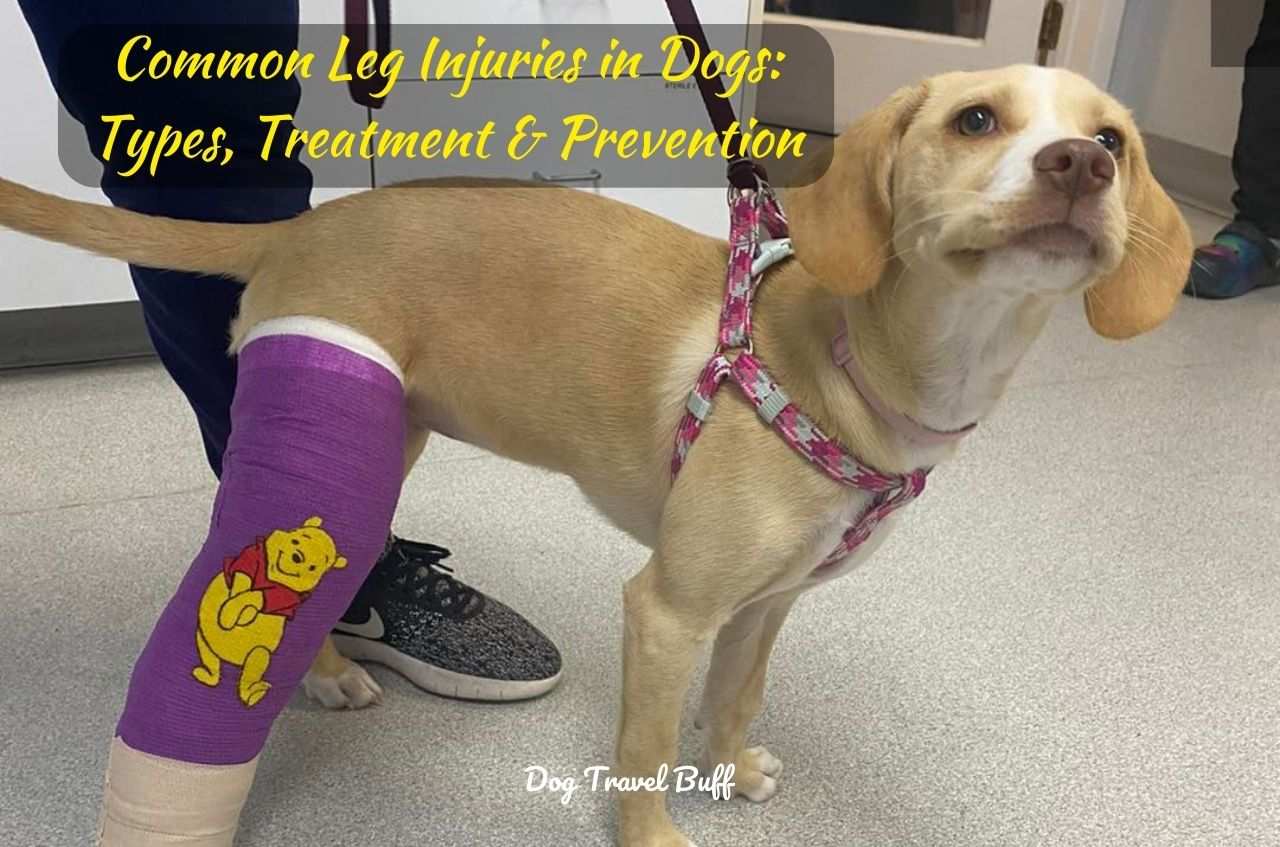7 Common Leg Injuries in Dogs: Types, Treatment & Prevention
Healthy legs are critical for a dog’s general well-being and movement. It allows them to do things like walk, run, and play. Dog leg injuries can vary from fractures and ligament tears to sprains and muscular strains, all of which can interfere with their everyday activities and quality of life.
This article seeks to give in-depth information on numerous leg injuries in dogs, including their causes, symptoms, diagnosis, treatment choices, and prevention measures.

This post may contain affiliate links. If you buy something through one of those links, you won’t pay any extra penny, but I’ll get a small commission that encourages me to deliver more helpful content for you.
Table of Contents
Common Types of Leg Injuries in Dogs
Let’s get to know some common types of canine leg injuries:
1. Fractured Leg
A fracture occurs in a dog’s limb when it sustains heavy injury or trauma, causing the bone to either partially or fully break.
Causes and Risk Factors:
Trauma, accidents, falls, or chronic stress can all lead to fractured legs in dogs. Age and underlying health issues, for example, may raise the risk.
Signs and symptoms:
Lameness, swelling, deformity, discomfort, and a reluctance to bear weight on the injured limb are all common symptoms of a broken leg.
Diagnosis and imaging techniques:
Physical examinations, X-rays, or other imaging techniques may be used by veterinarians to correctly diagnose and characterize the degree of the fracture.
Treatment options (Surgical and non-surgical):
Depending on the degree of the fracture, the best treatment options for a fractured leg in a dog differ. Casting, splinting, external fixation, or surgical intervention with pins, plates, or screws are examples.
Recovery and rehabilitation process:
Some of the best recovery tips for dogs with broken legs include taking rigorous rest, opting for proper pain treatment, and undergoing follow-up exams. You must also progressively increase their exercises and physical therapy training to help the dog regain strength and mobility. Some effective physical therapy exercises for a dog with a leg fracture are leash walk, swimming, sit and stand, and stand and stay exercises.
2. Sprained and Strained Legs
Any kind of physical trauma to the soft tissue of the ligament in a dog’s leg results in a sprain or strain. It mostly occurs around a joint.
Causes and Risks Factors:
Let’s get to know how to identify signs of a sprained leg in dogs. Sprained and strained legs in dogs are frequently caused by rapid twisting movements, overexertion, or accidents while participating in athletic activity. Obesity and poor muscular health can also raise the risk.
Signs and symptoms:
Limping, soreness, swelling, muscular stiffness, and trouble moving the afflicted limb are all symptoms of a strained or sprained leg.
Diagnosis and assessment:
To diagnose and assess the severity of an injury, veterinarians may do physical examinations, measure the range of motion, and occasionally employ imaging methods.
Conservative treatment approaches (rest, pain management, physical therapy):
Rest, reduced activity, pain management, and the use of anti-inflammatory drugs are common treatments. Non-surgical remedies for strained legs in dogs include physical therapy, which includes exercises and stretches. Continued rest and follow up visit to the doctor will be crucial in your dog’s recovery from a leg sprain.
Prevention strategies:
Physical therapy can also expedite the healing process and help avoid future injuries.

3. Ligament Injuries
When a dog’s ligament that joins the thigh bone to the shin bone suffers a tear, it is known as a ligament injury.
Causes and Risks Factors:
Ligament rips, for example, might develop as a result of an abrupt twist, excessive stress on the joint, or recurrent tension. Certain breeds and obesity may put dogs at risk for such injuries.
Signs and symptoms:
A torn ligament can cause lameness, swelling, discomfort, joint instability, and trouble bearing weight on the afflicted limb.
Diagnostic methods (e.g., physical examination, imaging):
A physical examination, evaluation of joint stability, and occasionally imaging methods such as X-rays or MRI scans are used to make a diagnosis.
Treatment options (surgical and non-surgical):
Treatment options range from conservative care (rest, pain medicines, physical therapy) to surgical intervention (ligament repair or reconstruction). It depends on the severity of the injury and the demands of the dog.
Rehabilitation and long-term management:
Exercises to help rehabilitate a torn ligament in a dog’s leg following a ligament injury; rehabilitation may include a combination of rest, supervised activity, physical therapy, and weight management.
4. Joint and Muscular Injury
Injury to the joint or muscle of a dog’s leg is a common type of ailment, especially in those dogs that engage in intense physical activity.
Common joint injuries:
Accidents, trauma, or underlying disorders can all result in joint injury. Dislocations, or separations of the joint surfaces, are a common kind of joint injury in dogs. Muscle injury can occur as a result of abrupt movements, overexertion, or trauma.
Muscle strains and tears:
Muscle strains and tears can result in discomfort, edema, and reduced motion.
Signs and symptoms:
Pain, swelling, lameness, trouble moving, and apparent deformity are among the symptoms of joint and muscle injuries.
Diagnosis and treatment options:
Physical tests, palpation, and, in rare cases, imaging methods are used to make a diagnosis. Rest, pain management, physical therapy, and, in certain situations, surgical intervention may be used as treatment.
Rehabilitation techniques:
Stretching, strengthening, and controlled motions are essential in the rehabilitation process to restore muscle function, increase joint stability, and promote healing.
Preventive Measures for Dog Leg Injuries
Below are some of the preventive measures for leg injuries in dogs.
1. Ensuring a secure environment
Provide a dog-friendly environment free of risks or impediments that might lead to falls or accidents. This entails recognizing possible risks in the dog’s living environment and taking precautions to reduce them. Removing sharp items, fastening loose carpets or rugs, and keeping floors clean of debris, for example, can reduce the chance of tripping or falling.
Stair gates can be used to limit access to potentially dangerous places, such as steep staircases. Accidents and leg injuries can be considerably decreased by maintaining a safe atmosphere.
2. Consistent exercise and conditioning
Regular exercise and conditioning suited for the dog’s age, breed, and fitness level helps build muscles and joints. Physical activity helps to maintain strong muscles, flexible joints, and general fitness. The type and degree of exercise should be appropriate for the dog’s age, breed, and physical condition. Gradually increasing the intensity and length of workouts can enhance endurance and strength while lowering the risk of strains and sprains.
3. Proper nutrition and weight control
Maintaining a healthy weight through a well-balanced diet can avoid leg strain and the risk of obesity-related ailments. Obesity puts too much strain on the joints, increasing the chance of injury and worsening pre-existing illnesses like arthritis. Providing a balanced meal with high-quality components and proper portion sizes aids with weight maintenance.
4. Avoiding undue physical exertion or repeated motions
Preventing overexertion, excessive leaping, or repetitive motions that can cause strain and wear on the legs. Stress on the joints and soft tissues might result from actions like high-altitude leaping, rigorous agility training, or repeated motions. It is important to offer adequate rest times during exercise and to prevent activities that are above the physical capacity of the dog.
5. Routine veterinary examinations and early intervention
Routine veterinarian check-ups should be scheduled to detect and treat any early symptoms of leg fractures or underlying diseases. Veterinarians may do thorough examinations, identify possible problems, and intervene early.
They can assess the dog’s stride, joint mobility, and muscle health to discover anomalies or alterations. Regular check-ups also enable the early diagnosis of problems such as hip dysplasia and patellar luxation, which can predispose dogs to leg injuries.
Many natural remedies for hip dysplasia in dogs are available that can be effective in treating the initial stages of the disease. Also, there are many natural techniques for preventing patellar luxation in canines if detected early. However, when it is diagnosed in the later stages, severe medical procedures might be needed to treat the acute issues.
Thus, with early intervention, proper treatment strategies may be implemented quickly. It lowers the risk of recurrence of the problem and promotes a speedier recovery.

Care and Management of Dogs with Leg Injuries
Dog limb injuries are fairly very common. In case the dog has an injury, let’s get to know what one should ensure.
Immediate aid and treatment
Provide urgent first aid, such as stabilizing the leg and avoiding additional injuries, before obtaining expert veterinary treatment.
Seeking veterinary assistance
Consult a veterinarian for an accurate diagnosis, treatment suggestions, and ongoing counseling during the healing process.
Pain management techniques
Use suitable pain medicines or treatments advised by the veterinarian to ensure the dog’s comfort during the healing process.
Assistive devices (e.g., splints, braces)
Use splints, knee braces for dogs, or a dog stroller to support the wounded limb and aid in healing under veterinarian care.
Physical therapy and rehabilitation activities
Physical therapy activities targeted to the dog’s individual ailment are directed by a specialist to improve healing, restore mobility, and avoid muscular atrophy.
Nutritional aid in healing and recovery
Provide a well-balanced, nutrient-dense diet to aid in the healing process and promote optimal recovery.
Long-Term Effects and Prognosis
The long-term outlook of your dog’s leg injury can be influenced by a variety of factors.
Potential complications and risk
Chronic discomfort, limited mobility, joint instability, muscle weakening, and an increased risk of future injuries are all possible effects.
Managing chronic conditions
Implementing long-term treatment techniques, such as weight control, activity adjustments, and continual monitoring, to address chronic problems related to leg injuries.
Monitoring and follow-up care
Regular veterinarian check-ups and follow-up sessions to monitor the dog’s progress, evaluate any new symptoms or concerns, and change the treatment plan as needed.
Factors affecting prognosis
The kind and degree of the injury, the dog’s general health, adherence to therapy and rehabilitation, and early intervention all influence the prognosis.
Conclusion
This thorough guide has addressed numerous leg injuries in dogs, which includes- fractures and breaks, sprains and strains, ligament injuries, and joint and muscle injuries. It also includes preventive measures, treatment, and long-term management.
Early detection of leg injuries, as well as early veterinary care, are critical to ensure accurate diagnosis, treatment, and rehabilitation, which leads to better results and a higher quality of life for dogs. If a dog exhibits indications of limb damage, lameness, or trouble moving, it is critical to visit a veterinarian for a complete assessment and suitable treatment.
Dog owners may contribute to the overall leg health of their cherished dogs by taking preventative steps, giving regular exercise, correct diet, and veterinary treatment, lowering the risk of leg injuries, and supporting a healthy lifestyle.
Read Next:
FAQs:
1. What are the common signs of a leg injury in dogs?
A: Dog limping is a common sign of a broken leg or other type of limb damage. Other symptoms of broken legs in dogs include unwillingness to bear weight on the injured leg, swelling, deformity or apparent bone protrusion, and a significant alteration in their pace or movement.
2. Are certain dog breeds more prone to leg injuries?
A: Breeds with special anatomical qualities or genetic predispositions are more prone to joint problems. The common dog breeds that are prone to leg injuries are Labrador Retrievers, Rottweilers, Maltese, German Shepherds, and French Poodles. Hip dysplasia, patellar luxation, and cruciate ligament tears are examples of joint ailments in these dog breeds.
3. How long does it take for a fractured leg in dogs to heal?
A: A broken leg of a dog typically heals in 6 to 8 weeks. However, the exact healing period for a fractured limb in dogs varies based on several factors, including the severity of the fracture, the location of the fracture, the dog’s age and overall health, and the treatment method used. Some fractures may need surgical intervention, such as the insertion of pins, plates, or screws to help stabilize the fracture and promote quicker healing.
4. Can a dog’s leg injury be treated without surgery?
A: Yes, in certain circumstances, a dog’s limb injury can be treated without surgery. It is determined by the nature and severity of the damage. Besides, identifying early signs of joint injuries in dog’s legs is critical for the effectiveness of non-surgical treatment methods. Some non-surgical treatment options for dog leg injuries include rest, restricted exercise, pain medication, physical therapy, and the use of assistive equipment like braces or splints.
5. What are the potential long-term effects of a leg injury in dogs?
A: A dog’s leg injury can have long-term consequences depending on the degree of the damage and the efficacy of therapy. One possible long-term impact is the development of chronic pain or discomfort, which may necessitate continuing pain management techniques. In rare situations, a dog may feel limited mobility or joint instability, particularly if the accident includes damage to the bones, ligaments, or joints. In such cases, you must support them with assistive equipment.






